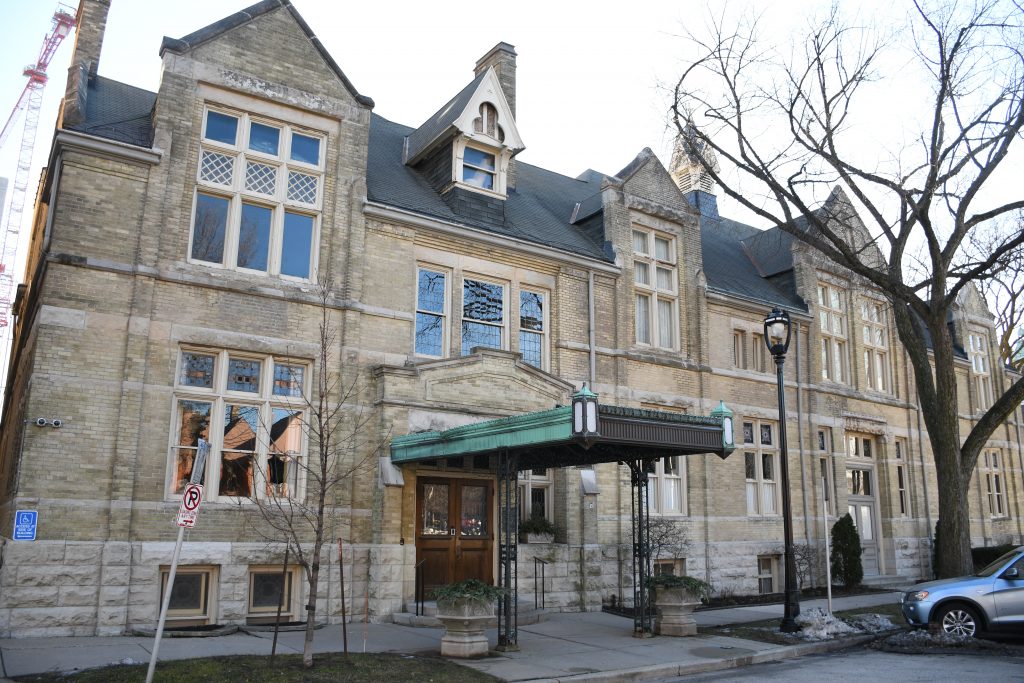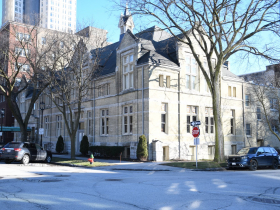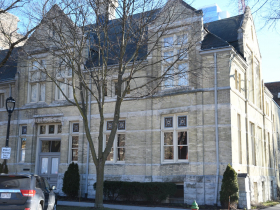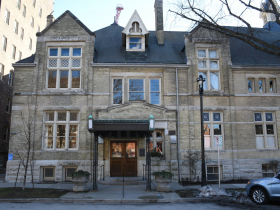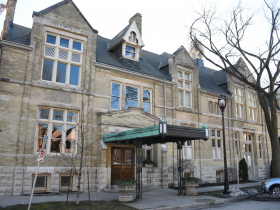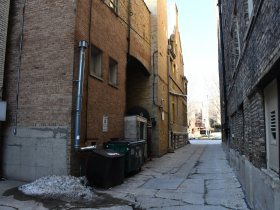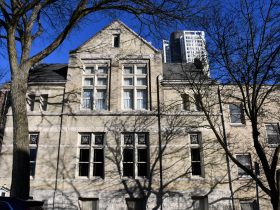Woman’s Club of Wisconsin Is Nation’s Oldest
With quite a history. But how did it get that tax exemption?
In October of the Centennial Year 1876 Julia Ward Howe traveled to Milwaukee to give a lecture at the home of Martha Reed Mitchell. If you think the abolitionist was fired up when she wrote the lyrics to “The Battle Hymn of the Republic” in 1861, you should have heard her on the matter of Women’s Rights in 1876. In January of that year, her husband Samuel Gridley Howe, eighteen years her senior, died. Although he and the mother of his six children had been separated for years, he had retained control of her finances. Upon his death, it was revealed the money was mostly gone due to his mismanagement. Thus, a financially depleted widow came prepared to deliver some choice words about self-reliance and female empowerment to the 30 women gathered at the Mitchell Mansion.
Howe was then the President of the New England Woman’s Club of Boston, established in 1868. In addition to attending to the Victorian-era social niceties that came with the job, Howe directed the group’s focus toward women’s suffrage and public education. In 1874, the club fused both issues when four women were elected to Boston’s school board — a baby step toward enfranchisement.
Howe’s message was simple: Milwaukee’s women needed such a club. The audience was receptive, and particularly well-suited to the task. Back in June 1865, Martha Mitchell had organized a massive street fair for the construction of the Soldier’s Home, raising $110,000. She could get things done. Alexander Mitchell, Martha’s husband, had just completed two terms in Congress. With his control of the Marine National Exchange Bank and the Chicago, Milwaukee and St. Paul Railroad (“The Milwaukee Road”), he was the wealthiest man in Wisconsin.
Martha’s friend Mary Elizabeth Blanchard Lynde was likewise the wife of a former congressman. She was also a reformer and was the first woman in Wisconsin to be appointed to public office when she was named to the Wisconsin Board of Charities and Reform in 1871.
With these two women at the helm, The Woman’s Club of Wisconsin was organized on Oct. 9, 1876. According to the Wisconsin Historical Society:
Thirty women at the first meeting pronounced themselves ‘not only weary, but rebellious’ against the idea that they should restrict themselves to a quiet, house-bound life of child-rearing and service to the Lord. ‘We have as much right to dwell in the sunlight and make a noise as our brother man.’
Get a daily rundown of the Milwaukee stories
The bylaws stated:
The object of this Club shall be primarily to elevate and purify our civilization. As a means toward this end, it shall seek to excite woman to intellectual and moral culture, and also to a careful study of the practical arts of our common life.
The excited women then formed the first women’s club west of the Alleghenies, helping to spur the growth of a veritable movement. By 1921 there were over 300 women’s clubs in Wisconsin, totaling 20,000 members, newly enfranchised by the 19th Amendment. Today, The Woman’s Club of Wisconsin is the oldest continually operating women’s club in the country. I doubt 300 such clubs in the entire nation survive to this day.
First Stock Company in World Organized by Women
At first the women met at members’ homes. This posed little hardship for Martha, whose palatial residence is now the Wisconsin Club, but such duties may have been a strain for other members less sumptuously domiciled. They gathered in hotels and church meeting rooms around the city, but after a decade of this nomadic and entirely unladylike existence, it was determined that a Woman’s Club’s place was in a home, so the members sought to build one to suit their needs.
With their traditional resolve, the women got down to business, and in so doing they made business history in 1886 by forming the world’s first public stock company organized by women. A thousand shares were offered at $25 per share; the goal was nearly met, and the club was able to borrow the remainder to buy a lot and plan construction of the first building ever specifically designed to serve as a woman’s club. The club hired George Bowman Ferry as the architect of the $14,000 structure, located at 221 Biddle St. (now 813 E. Kilbourn Ave.), and named it the “Athenaeum.” Apparently, the first directive was that the men’s bathroom must be located in the basement. That feature alone made the club unique among its peers.
The Clubhouse in History
Ferry planted his symmetrical 85-foot by 45-foot clubhouse at the southeast corner of the intersection of Biddle and Cass streets. We learn from its 1982 listing on the National Register of Historic Places that it is of frame construction, with a veneer of Cream City brick and “foundation, courses, sills and lintels of ashlar” running in horizontal bands, interrupting the pronounced verticality of the prominent windows. “A small, cross-gabled flèche rise(s) from the roof.” This was added to the original structure in an 1896 expansion to the east. You can see it perched atop the center of the roof of the original structure; an excrescence. It and a trefoil gable centering the addition are the only Gothic elements in the architecture, while the Romanesque Revival body, being austere, unfussy, and dressed just so, presents a good front, befitting a proper Victorian lady.
Women’s clubs looked with envy upon the Milwaukee stock company model as a way to build a home of their own. In 1888, word from Indianapolis arrived that “Our Propylaeum will soon vie with your Athenaeum.”
The Milwaukee building stayed true to its mission, hosting the city’s first public cooking club, the early Boys’ Club, Unitarian services while that church (also designed by Ferry) was being built nearby on Ogden Avenue, art lessons, and the National Whist Conference of 1900. The members promoted home economics and manual arts training in public schools, along with recreational activities. The Welfare Committee helped sponsor the hiring of Milwaukee’s first woman probation officer in 1926.
Utilitarian additions in 1936 and 1950 to the south brought the building’s footprint to 100-feet by 80-feet and housed the kitchen, support and social rooms. They are not considered to be of architectural significance.
The Clubhouse Today
The clubhouse remains in excellent condition. Just months ago, crews worked on the facade of the building, which is in fine repair. Of course, old buildings always have problems. The city inspector found that the juice machine on the second floor required backflow protection as did the “laundry sink in the basement (cage area).” Whist has been replaced with scheduled games of Mahjong and Duplicate Bridge, bright and early at 10 a.m. Perhaps to draw younger members, the club may someday offer newer diversions such as Tetris and Ms. Pacman. There exist committees to consider such changes.
On Feb. 22, there will be a dinner with Derek Mosley, so the kitchen must be at its best for that event. A week later, there will be a “Dinner with the Poets,” which could be a disaster if the poets consider pre-dinner cocktails to be a sufficient meal. The upper floor has a barrel-vaulted ballroom that could host a quadrille of 400. The interior is well-appointed, and the Emily Groom landscape in the foyer is just one of many treasures of the place, including paintings by female artists collected by Martha Mitchell. The interior has much in the way of furniture and artifacts donated by members over the decades. A painting’s frame has recently been documented as being designed by Cass Gilbert! You get the picture.
Tax Exempt Since 1931
For tax purposes, most such clubs are considered “Social Welfare Groups” (501(c)4 corporations) and are thus non-profit organizations exempt from income tax. Unlike charitable 501(c)3 organizations, contributions are not tax-exempt, nor is their property.
Unless it is a club for women.
Chapter 302 of the Laws of 1931 amended the property tax exemption under Wis. Stat. § 70.11 (4) to include women’s clubs, and it was signed into law by Governor Philip La Follette. A news account of the time noted “women’s clubs throughout the state urged passage of the bill.” Women could vote, and they had clout. The assessor’s file in City Hall is empty, save for a newspaper clipping from Sept. 21, 1955 that included a photograph of three generations of club members — Mrs. George P. Miller (a member since 1889), Mrs. William Merrill Chester, and her daughter Mrs. Verne Ross Read (1919-2014). I attended the latter’s funeral. It was held at the Woman’s Club.
The Milwaukee assessor has a hard enough time discovering, listing and placing a value on all taxable real estate so little attention is paid to nontaxable properties. Since the city first began putting an estimated value on such parcels in 2018, the Woman’s Club has held steady at $94,000 for the 10,890-square-foot lot ($8.63/s.f.) and $170,000 for the building, for a total of $264,000.
The $8.63 per square foot assessment is an absurdly low value for prime downtown real estate. The taxable land value next door is $49.44 per square foot, which is more like it.
Chief Assessor Bill Bowers tells me:
Our office does not value “exempt properties” because they are not part of our Ad valorem assessment and are not used in the development of the municipal valuation. Some valuations may appear on the exempt property record card or in our property assessment system based on previous valuations, but those are overridden by the exempt status of the property.
Separate Surface Parking Lot also Exempt
Just down the street at 810 N. Cass St., the Woman’s Club also owns an 18,295-square-foot surface parking lot for members. The land is valued at $450,000 — or $24.54 per square foot. Closer in market rate than the clubhouse land, it is still about half of that of other properties in the area. There is a little shed that is valued at $12,500 on the property. Yet this $462,500 parcel is also exempt from property tax. At a time when private clubs are struggling, these exemptions provide a nice cushion for the members of the Woman’s Club of Wisconsin. It should be noted that the club has admitted men as members since 2000, with local historian E. J. Brumder being its first.
Photos
The Rundown:
- Name of Property: The Woman’s Club of Wisconsin; “The Athenaeum”
- Address: 813 E. Kilbourn Ave., City of Milwaukee
- Assessed Valuation: The 10,741-square-foot lot is assessed at $94,000 ($8.75/s.f.), and the improvements are valued at $170,000 for a total assessed valuation of $264,000. Exempt
- Taxes: $0, Exempt
- Owner: Woman’s Club of Wisconsin. Established October 1876. Organized as a stock company (first in world controlled by women) to finance construction of clubhouse, 1886. Organized as a non-stock Wisconsin corporation Jan. 27, 1910. Patti Muccio, Registered Agent.
- Type: Commercial Exempt
- Architect: George Bowman Ferry
- Style: “Late Gothic Revival Romanesque,” according to National Register of Historic Places, 1982
- Year Built: 1887; numerous updates over the years, 1896, 1936 (Eschweiler and Eschweiler) and 1950. Recognized by City of Milwaukee Historic Landmarks Commission, 1970. Plaque affixed to structure
- Neighborhood: Juneau Town
- Aldermanic District: 4th; Robert Bauman
- Walk Score: 95 out of 100 “Walker’s Paradise”
- Transit Score: 64 out of 100 “Good Transit”
- Bike Score: 82 out of 100 “Very Bikeable”
How Milwaukee is it? It is 0.5 miles, or a 12-minute walk, from City Hall
If you think stories like this are important, become a member of Urban Milwaukee and help support real, independent journalism. Plus you get some cool added benefits.
What's It Worth?
-
Milwaukee Yacht Club Worth $2.28 Million
 Mar 27th, 2024 by Michael Horne
Mar 27th, 2024 by Michael Horne
-
Wisconsin Club Worth $5.1 Million
 Mar 17th, 2024 by Michael Horne
Mar 17th, 2024 by Michael Horne
-
University Club Milwaukee, $2,728,500
 Dec 25th, 2023 by Michael Horne
Dec 25th, 2023 by Michael Horne


